Volkswagen Atlas vs Atlas Cross Sport: Which VW SUV Is Best?
February 7, 2024
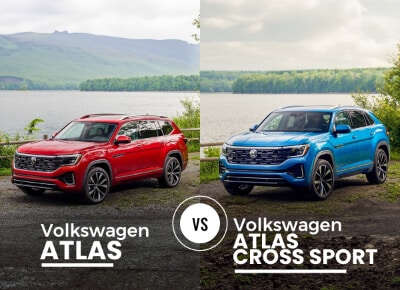

Rich Taber has nearly three decades of professional writing experience, including eight years as an automotive columnist for The Standard-Times newspaper, seven years on staff at WheelsTV as a scriptwriter, production manager, and editorial vice-president, and five years as CEO of RPM News Weekly. He has written extensively for numerous regional and local publications and developed public relations products for many non-profit organizations. Having studied both engineering and liberal arts at the University of Notre Dame and worked in audio/visual services, electronic sales, graphic design, and event and entertainment production, he brings a well-balanced skill set to his automotive writing.
Spacious family haven or sporty city conqueror? Unsure which Volkswagen SUV suits your style?
We dissect the 2024 Atlas and Cross Sport, comparing size, features, performance, and safety to help you find the option that's right for you.
- Choose the Atlas if you need maximum cargo space, particularly behind the 3rd row, or prioritize seating for 7 passengers comfortably.
- Choose the Atlas Cross Sport if you prefer a sportier design, prioritize cargo space behind the 1st and 2nd rows, and don't require the 3rd row.
Table of Contents
- Volkswagen Atlas vs Volkswagen Atlas Cross Sport Comparison
- Tale of the Tape
- Cabin Quality and Design
- Performance & Powertrains
- Safety Equipment and Scores
- Current Volkswagen Atlas Deals & Incentives
- Current Volkswagen Atlas Cross Sport Deals & Incentives
- So, Which Is Better, the Atlas or the Atlas Cross Sport?
- Car Research & Comparisons
Volkswagen Atlas vs Volkswagen Atlas Cross Sport Comparison
| Specifications | Volkswagen Atlas | Volkswagen Atlas Cross Sport |
| Body Style | Traditional SUV | Sleeker, sportier SUV |
| Cargo Space (behind 1st row/2nd row/3rd row) | 96.8 cu ft / 77.4 cu ft / 20.6 cu ft | 77.8 cu ft / 40.4 cu ft / N/A |
| Passenger Space (headroom/legroom) | More spacious, especially in 3rd row | Slightly less spacious, particularly in 2nd row |
| Towing Capacity | Up to 5,000 lbs | Up to 2,000 lbs |
| Fuel Economy | Slightly better overall (20-26 mpg) | Slightly lower overall (19-25 mpg) |
| Starting Price | Lower ($37,725) | Slightly higher ($36,715) |
What's Similar?
- Both offer spacious interiors with 3-row seating (except Atlas 2WD base trim).
- Both boast standard driver-assistance features like forward collision warning, automatic emergency braking, and blind spot monitoring.
- Both come with an available turbocharged 2.0L engine and 8-speed automatic transmission.
- Both received 4-star safety ratings from the NHTSA.
- Both have starting prices in the mid-$30,000 range.
Tale of the Tape
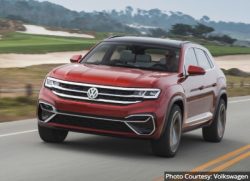 The 2024 Atlas dwarfs its sibling, the Cross Sport. 5 inches longer, wider, and taller, the Atlas boasts significantly more space.
The 2024 Atlas dwarfs its sibling, the Cross Sport. 5 inches longer, wider, and taller, the Atlas boasts significantly more space.
Need to pack the car to the brim? The Atlas offers a cavernous 96.8 cubic feet behind the first row, compared to the Cross Sport's max of 40.4. However, if agility and a sleek profile are priorities, the Cross Sport shines.
Size-wise, the Atlas dwarfs the Atlas Cross Sport:
- Length: 196.8 inches vs. 191.5 inches (over 5 inches longer)
- Width: 77.3 inches vs. 73.3 inches (nearly 4 inches wider)
- Height: 70.1 inches vs. 65.5 inches (almost 5 inches taller)
The Atlas truly shines for families and cargo haulers, while the Cross Sport provides a sleeker, more compact alternative.
Cabin Quality and Design
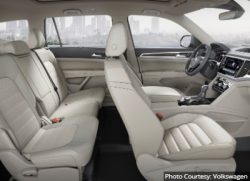
While the Atlas offers more elbow room, the Cross Sport boasts a modern and refined interior. Premium materials and available features like a digital instrument cluster and head-up display elevate the Cross Sport's feel.
Both offer features like heated seats, panoramic sunroof, and heated steering wheel, but the Cross Sport might have them standard in higher trims.
Tech-wise, both benefit from touchscreen infotainment systems with Apple CarPlay and Android Auto, but the Cross Sport's latest MIB3 system might offer additional features and responsiveness.
Remember, the Atlas's size also translates to more storage cubbies and compartments for keeping your belongings organized.
Performance & Powertrains
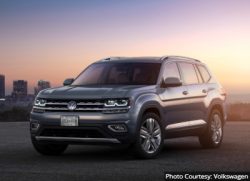
Both share a 2.0L turbocharged engine with 269 horsepower and 273 lb-ft of torque, offering ample power for daily driving.
However, the Atlas prioritizes fuel efficiency with 20-26 mpg combined, while the Cross Sport leans towards sportiness with slightly lower (19-25 mpg) fuel economy.
The Atlas offers an optional V6 engine with 309 horsepower for even more muscle, but this option sacrifices fuel efficiency. Both come with all-wheel drive options for tackling wintery conditions or light off-roading (the Atlas Peak Edition is particularly capable).
Ultimately, the Atlas provides powerful towing capabilities (up to 5,000 lbs), while the Cross Sport caters to those who prioritize nimble handling and a slightly sportier driving experience.
Safety Equipment and Scores
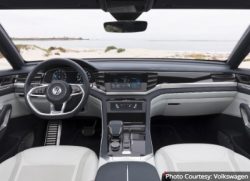
Both vehicles prioritize safety with features like:
- Forward collision warning with automatic emergency braking
- Blind spot monitoring and rear cross-traffic alert
- Lane departure warning and lane-keeping assist
- Adaptive cruise control
Both received 4-star safety ratings from the NHTSA.
However, the Atlas earned a "Good" rating on all IIHS tests, while the Cross Sport received a "Good" rating in most tests but fell short with an "Acceptable" rating on headlights.
While both are safe choices, the Atlas might offer a slight edge in overall safety based on IIHS ratings.
Current Volkswagen Atlas Deals & Incentives
| Year | Make | Model | Cash Incentives (up to) | Best Avail. APR | Lease Offers | Expiration |
|---|---|---|---|---|---|---|
| 2023 | Volkswagen | Atlas | ||||
| 2024 | Volkswagen | Atlas | 0.90% | $449/month for 36 months, $4,999 due at signing | 9/3/24 |
You may qualify for additional deals and incentives, check out this month's Volkswagen deals here.
Current Volkswagen Atlas Cross Sport Deals & Incentives
| Year | Make | Model | Cash Incentives (up to) | Best Avail. APR | Lease Offers | Expiration |
|---|---|---|---|---|---|---|
| 2023 | Volkswagen | Atlas Cross Sport | ||||
| 2024 | Volkswagen | Atlas Cross Sport | 0.90% | $439/month for 36 months, $4,999 due at signing | 9/3/24 |
You may qualify for additional deals and incentives, check out this month's Volkswagen deals here.
So, Which Is Better, the Atlas or the Atlas Cross Sport?
The choice between the Atlas and Atlas Cross Sport hinges on your priorities:
- Spaciousness and cargo hauling: Go for the Atlas, especially if you need 3-row seating.
- Sleek design, sporty handling, and modern tech: Opt for the Cross Sport.
- Fuel efficiency: The Atlas edges out slightly, but choose the Cross Sport if ultimate efficiency isn't crucial.
- Safety: Both excel, but the Atlas boasts top ratings in all IIHS tests.
Posted in Car Buying Tips, Car Research & Comparisons |







